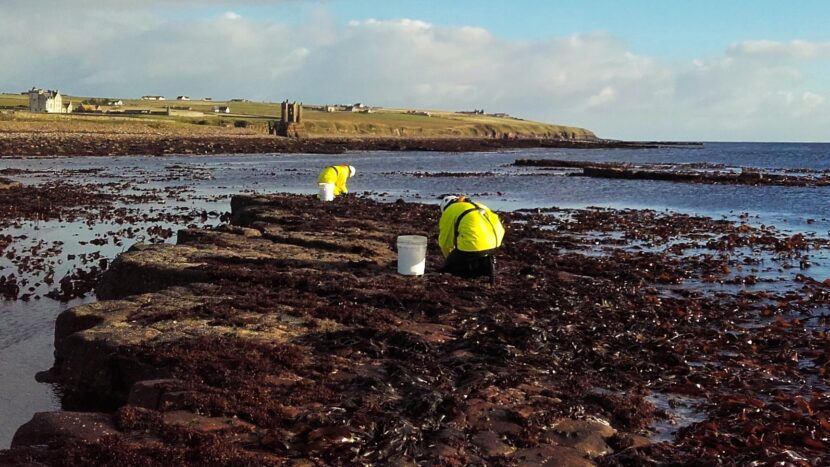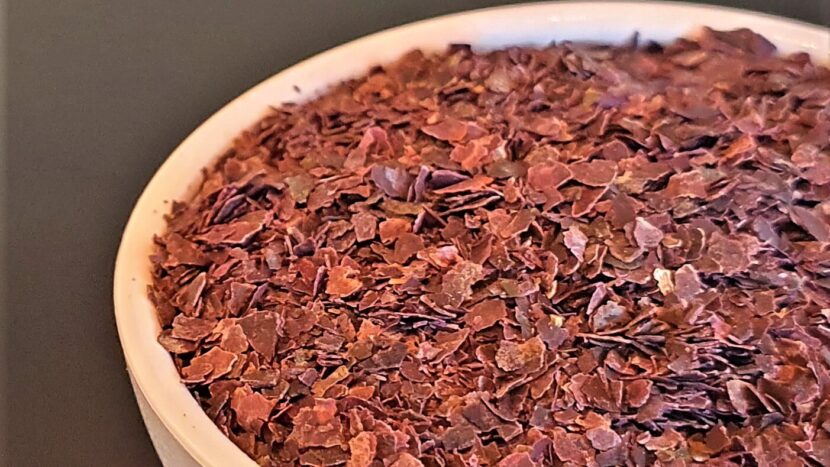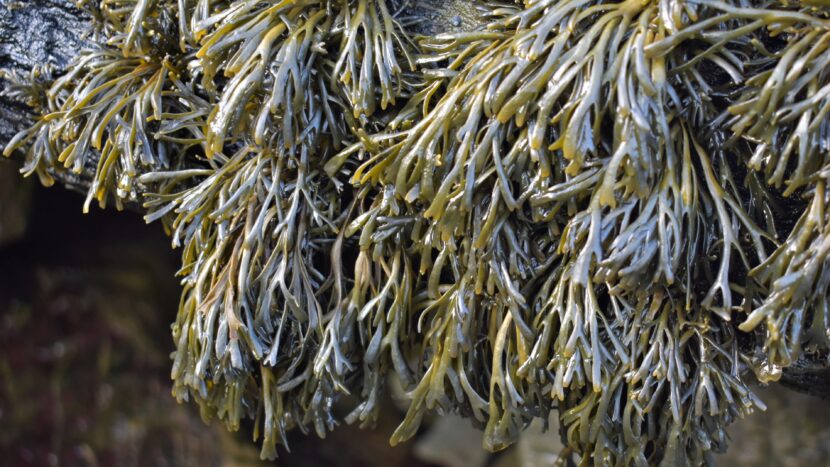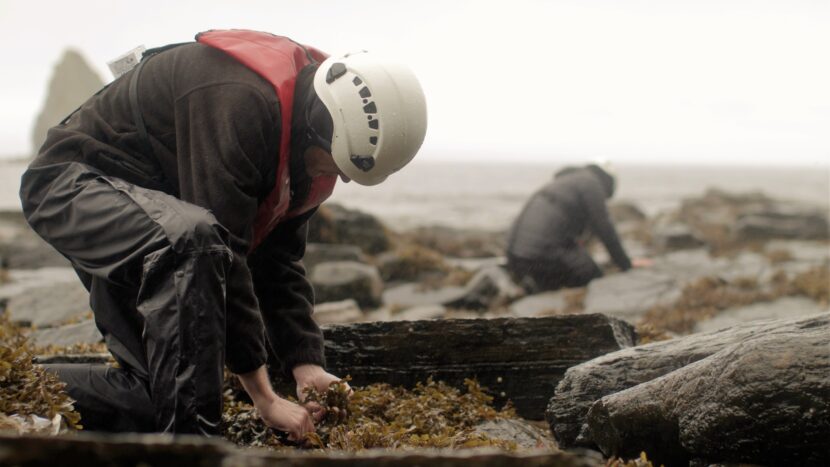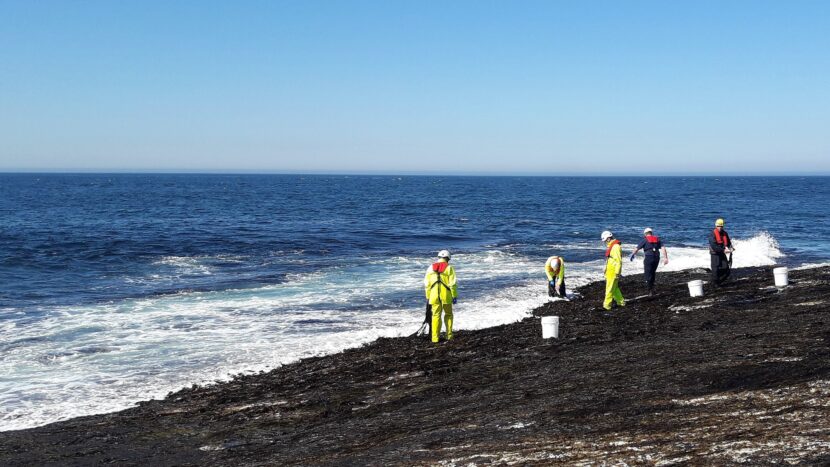Sodium and seaweed: potential for salt replacement?

It is widely understood that too much sodium is bad for our health. One of the common uses mentioned for seaweed is salt substitution. Potassium, magnesium and calcium are among the minerals that contribute to the salty flavour of seaweed, but sodium is also an important component. We explore this interesting and significant topic in this article.
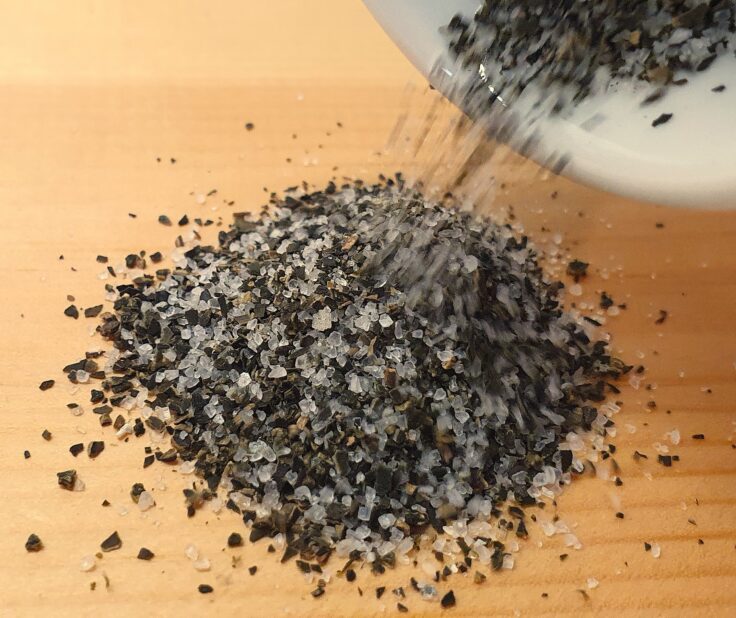
Seaweed can be blended with salt to help reduce sodium content in food and drink products
Salt and sodium
While there are many different salts in chemistry, the table salt familiar to us all is sodium chloride. It has the formula NaCl – one molecule comprises one atom of positively charged sodium and one atom of negatively charged chlorine. This distinction is important because it is the sodium that is relevant to health, but levels can be confused with salt. Using molecular weights, pure sodium chloride is 39.3% elemental sodium: divide the salt content in any food by 2.5 to reach the sodium level. We will try and keep to referring to sodium content in this article to help avoid confusion.
Pure sodium does not exist in nature and must be created from sodium compounds. It is a silvery, soft alkali metal that is highly reactive with water (as we might remember from school chemistry). Sodium has leached from rocks into water over millions of years and is now abundant in the environment. Table salt is mined rock salt deposits formed from ancient oceans. Sea salt is evaporated brine, either by applying heat or naturally in the sun.
Contrary to what some marketeers say, table salt and sea salt and have very similar nutritional value. Researchers who analysed a range of salt types found no significant difference in sodium levels. Sea salt may contain the wider array of trace minerals, but it is unwise to add salt when aiming to boost intake of micronutrients. Salt used in food must be at least 97% sodium chloride, leaving little room for other elements. Artificially produced potassium chloride can be incorporated to produce a reduced sodium table salt: LoSalt is an example. However, high potassium intake can be an issue for people with certain health conditions. As we covered in our seaweed and thyroid health article, iodisation of salt has been shown to be a cost effective measure to improve the health of deficient populations.
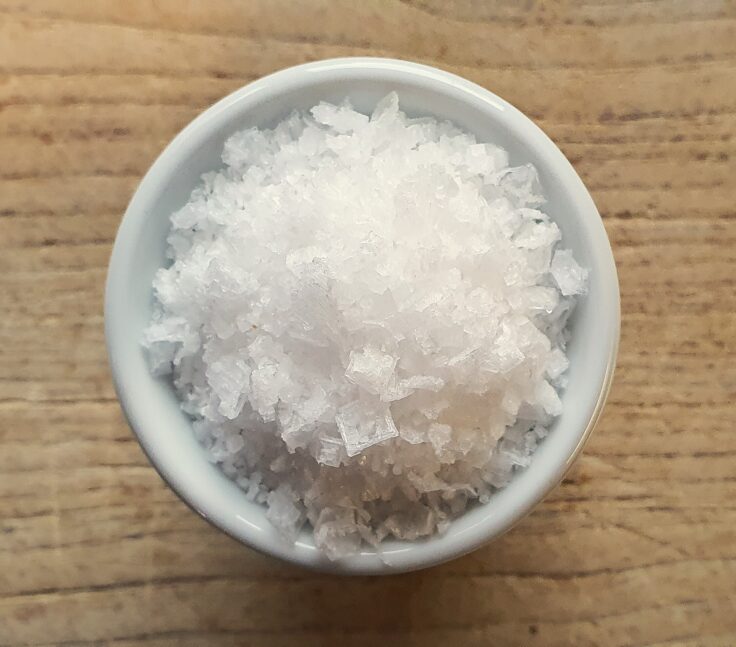
While sea salt is prized for flavour and texture, it has the same sodium content as table salt and should not be considered the healthier option
The importance of sodium for our health
Sodium is an essential element for all animals. Sodium is the dominant electrolyte in extracellular fluid and plays a critical biochemical role relating to osmotic balance and nerve and muscle function. Sodium is a key electrolyte, along with calcium, potassium and magnesium, and our bodies excel at controlling their levels. We need to consume some sodium in our diet, but this minimum quantity is difficult to discern: a Brown University article states that an adult needs just 200-500mg of sodium each day. A bowl of cornflakes might contain enough sodium to reach this intake level. The ubiquity of salt in our modern diet means that is unlikely a healthy person will have sodium deficiency. Hyponatremia occurs when blood sodium levels are low and is relatively common in hospitalised patients and people competing in endurance events.
It is worth clarifying that there are no approved health claims for sodium, even though it is recognised as an essential micronutrient. The European Food Safety Authority considered a health claim relating to normal muscle function in 2011. Despite acknowledging a connection to sodium, there is no indication that low sodium intake impairs muscle function and so a health claim was not recommended. The committee also emphasised the important health benefits from reducing sodium in the European diet.
The negative health impacts of high sodium intake are widely known. Higher sodium levels in blood lead to more water being pumped around the body, in turn increasing blood pressure. This is known as hypertension and is one of the critical risk factors for cardiovascular disease. A meta-analysis published in The BMJ in 2009 showed that sodium intake is associated with significantly increased risk of stroke and total cardiovascular disease, with the stronger associations with larger differences in sodium intake.
The latest available data shows that the average daily sodium intake for adults in England is 3.4g, with men consuming 3.7g and women 3.0g. This is substantially higher than the maximum intake of 2.4g recommended by the NHS and the 2.0g advised by the European Food Safety Authority. Our media makes us aware of how poor our diet is in the UK. However, an analysis of sodium intake in Europe published in 2022 found the UK figure to be the lowest out of those countries that collect the highest quality data.
Sources of sodium in our diet
Action On Salt raise awareness of the negative health effects and campaign to reduce the amount of sodium in the UK diet. They produce reports on different food categories: their 2023 report on pizza is an eye opener. An article on the Action On Salt website summarises dietary sources of sodium, based on Public Health England research. The majority of sodium in our diet is added to processed food (61%). The remainder is split between sodium naturally present in unprocessed foods (21%) and sodium added during cooking or at the table (18%). Some of the worst offenders are cereal products (especially bread), meat, ready meals and cheese. Not all sodium is from salt: other sources in the diet can include flavour enhancers (e.g monosodium glutamate), preservatives (e.g. sodium metabisulphite) and processing aids (baking soda).
Sodium plays an important role beyond simply adding a salty flavour. It enhances the flavour of other ingredients and improves texture in a range of products. Bread is a great example: sodium inhibits fermentation by yeast, allowing gluten to strengthen. Bread can be made without sodium, but will lack the crumb and crust sought after by bakers. Sodium also provides specific processing benefits:
- Increased water-holding capacity
- Maturation of cheese
- Preservation by reducing water activity
Is seaweed low in sodium?
We often see claims that seaweed is a low sodium alternative to salt. The statements ‘low sodium’ and ‘low salt’ are protected within food law:
- Low sodium if the product is <0.12% sodium
- Very low sodium if the product is <0.04% sodium
- Sodium-free if the product is <0.005% sodium
Seaweed contains too much sodium to qualify for any of these statements. Horizon Seaweed has been involved in numerous projects over the years where different species have been analysed for their nutritional value: the rule of thumb we use across the varieties we supply is sodium level is typically around 3%. The lowest species analysed in our research projects is dulse at an average content of 0.7% sodium, substantially above the low sodium nutritional claim.

Levels of sodium tend to be lower than calcium and potassium in the species we supply (data aggregated from analysis of wild Caithness seaweed by the Rowett Institute and the Environmental Research Institute).
Seaweed gets its salty flavour from a variety of minerals that are all important for our health. The most abundant are calcium, potassium, magnesium and sodium: these four elements make up around 10% of the dry weight of seaweed (based on data aggregated from projects with the Rowett Institute at the University of Aberdeen and the Environmental Research Institute in Thurso, with data from the latter published in 2022.
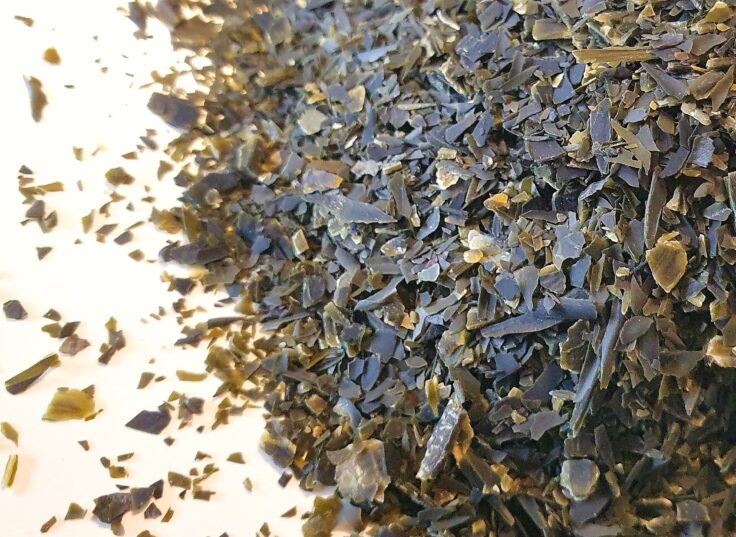
Atlantic wakame is a variety of seaweed with a higher content of potassium than sodium
In the species we supply, sodium content is generally lower than levels of calcium (e.g. toothed wrack, bladder wrack) and potassium (e.g. Atlantic wakame, dulse). A product can be labelled as a source of a nutrient if a portion contains at least 15% of the recommended daily intake. Of course, a portion of seaweed is generally quite a small quantity, especially when staying within a reasonable iodine limit. Adding seaweed to a food or drink product may help achieve a nutrient claim for calcium, potassium or magnesium. However, it will depend on inclusion levels and contributions to mineral levels by other ingredients.
Using seaweed to replace sodium
Although it is clear than pure seaweed cannot be considered low sodium, it can be used to replace table salt or sea salt in food products; seaweed substitution provides opportunities for those end products to achieve legally compliant sodium-related health claims. This includes a ‘low’ or ‘free’ claim if the level in the finished product is below the thresholds outlined above. There is also potential to achieve claims of:
- Reduced sodium if the reduction in sodium is at least 25% lower than a similar product
- No added sodium if salt is not an ingredient in the product AND the product is <0.12% sodium
Any product achieving at least a ‘low sodium’ level is also permitted to use the approved health statement that reducing consumption of sodium contributes to the maintenance of normal blood pressure. Salt content is part of mandatory labelling requirements, but a statement indicating that salt levels are exclusively due to the presence of naturally occurring sodium may appear near the nutrition declaration in a qualifying product. Front-of-pack labelling in the UK is voluntary, but most major supermarkets and manufacturers apply the Government’s recommended traffic light coding. The low sodium threshold aligns with the ‘green’ label in this system. The ‘amber’ sodium level is between 0.12% and 0.60%: this provides an opportunity for seaweed substitution to naturally reduce sodium levels below the unhealthy ‘red’ label.
We often see seaweed suggested as a salt replacement. However, our experience in discussing this topic with different food manufacturers means that we need to consider this in more detail. Indeed, the subject has been widely researched by food and nutrition scientists for a couple of decades now. It is often the case that swapping out some salt content for seaweed will be more successful than complete replacement. This allows for a reduction in the sodium content while maintaining a desired level of seasoning.
Recent consumer trials of bread made with brown seaweed – the authors do not state the species sadly, but a little detective work suggests it was knotted wrack – found that 20% salt reduction was acceptable to consumers. Interestingly, when a bread sample was identified as containing seaweed, there was an increase in saltiness perceived by the participants. Reductions in salt content beyond 20% in the seaweed bread were poorly received. A study in Malaysia investigated the impacts of adding seaweed to salt-reduced chicken patties. The overall consumer acceptability of the chicken patties with 1% salt and 4% seaweed was significantly higher than the control with 1.5% salt and no seaweed. The formulation used a carrageenophytic seaweed: carrageen extracts are already used in food processing and textural analysis in this study showed the seaweed improved water holding capacity, decreased shrinkage and darkened colour. Research in Ireland found that an inclusion of 1% sea spaghetti in a low-salt beef burger was a success, both in terms of organoleptics and – importantly – the emotional aspects of incorporating an unusual ingredient into a mainstream product. The study found that a blend of salt and seaweed evoked more positive emotions than samples with only salt or only seaweed (including satisfaction, pleasure and happiness).

Seaweed species must be carefully selected for salt substitution: even small quantities of Irish moss will influence the texture of the end product
The best varieties of seaweed for salt replacement
Does the type of seaweed really matter? It appears frankfurters can help shed some light! In a Korean study comparing different Asian species in pork sausages where salt was reduced from 1.5% to 1%, two varieties improved sensory characteristics to levels similar to the regular salt control but two were less successful. This mirrors the findings of an Irish project that tested four different species in frankfurters with salt inclusion lowered from 2% to 1%: the product using sea spaghetti was more promising than reformulations using nori, dulse or Asian wakame.
The Horizon Seaweed team agree it is important to carefully consider different species when looking at salt substitution. Some varieties may overwhelm other ingredients in a product (e.g. bladder wrack). In our experience, seaweed flavours mature over time: seaweed bread may have a stronger taste on the second day. It is also possible that a seaweed will have impacts beyond sodium reduction: Irish moss will have an impact on texture even at low inclusion levels. Table salt is cheap ingredient and, unfortunately, some species are simply too expensive to be viable for sodium reduction alone (e.g. dulse). However, a lower sodium content could be a fortuitous outcome if using seaweed to impart certain flavours (e.g. vegan seafood). Seaweed also has the benefit of naturally enhancing flavour. Some salt replacements actually utilise flavour enhancers to compensate for the lack of sodium: BonSalt is mostly potassium chloride but includes glutamic acid.
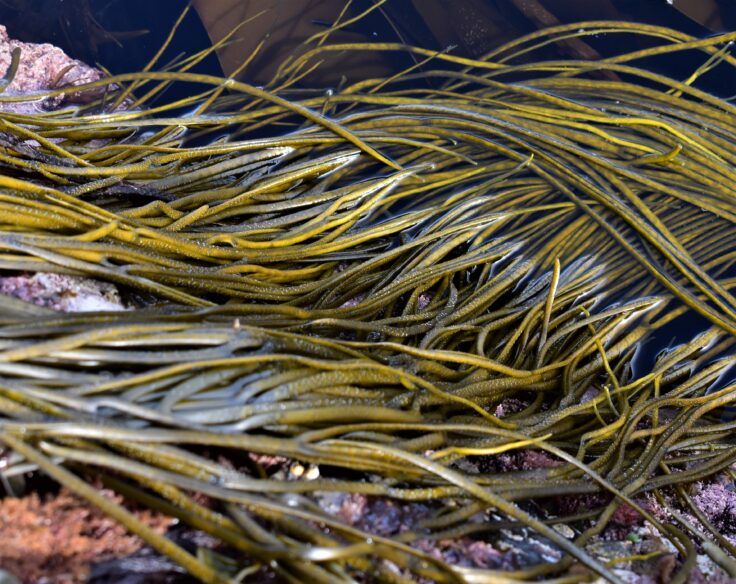
Our top pick for salt replacement is sea spaghetti, a species named for its elongated fronds but best used finely milled
We do not advise using kelp or sugar kelp for salt replacement. This is principally because they have a very high iodine content, which means only trace amounts should be consumed. The variety we recommend most often is sea spaghetti. This is a species named for its shape and, although sold as a pasta substitute, is far better suited to seasoning applications. Among the nine species analysed by the Rowett Institute and the Environmental Research Institute, sea spaghetti actually has the highest levels of sodium (4.7%), potassium (7.2%) and magnesium (0.8%). This means it has a dominant salty flavour, with more neutral tones compared to wracks. Sea spaghetti also has one of the lowest iodine contents of the seaweeds that we supply and so can be used in greater quantities.
Two simplified examples:
- Replacing 33% of added salt in a pizza with milled sea spaghetti will reduce sodium by 29%, achieving a ‘reduced sodium’ claim.
- A sauce with a sodium content of 1.0% would bear a red voluntary health label, but swapping 50% of the salt for milled sea spaghetti could reduce sodium down to below the threshold for an amber label (0.6%).
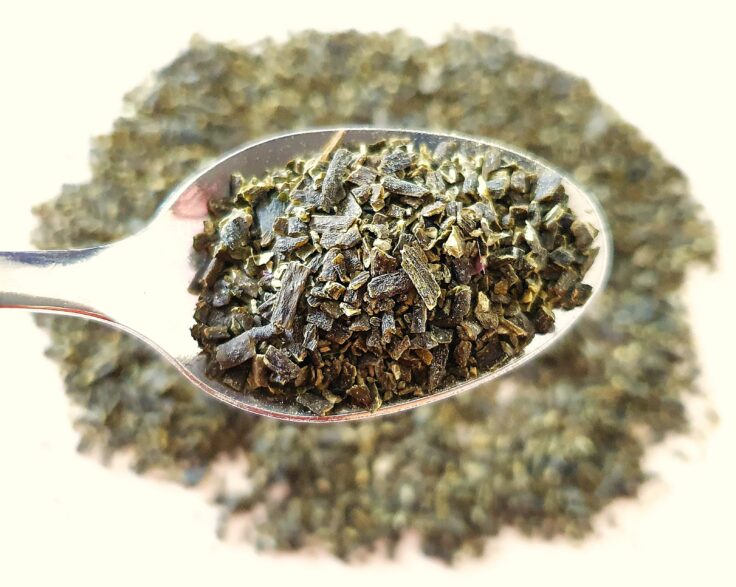
Milled sea spaghetti can easily be added to a variety of dishes
Targeted applications for sodium reduction
There are great opportunities to use seaweed for naturally reducing sodium content in foods. Seaweed is a food of the future and can also provide traces of other essential minerals. It is important to reiterate that salt – either from rock or sea – is not a source of any elements other than sodium and chlorine. There are very few sodium substitutes available and seaweed is a viable alternative. The Action On Salt campaign actually recommends trying milled seaweed as salt replacement in a tomato and pasta sauce. Celebrity chef Heston Blumenthal worked with the University of Reading on a project for Age UK that aimed to improve the taste of hospital food: seaweed was recommended to help reduce sodium but retain savoury flavour.
Please get in touch with us for more advice on how to use seaweed for salt substitution.

